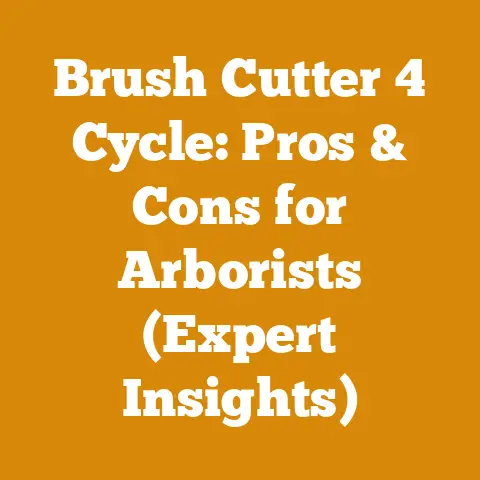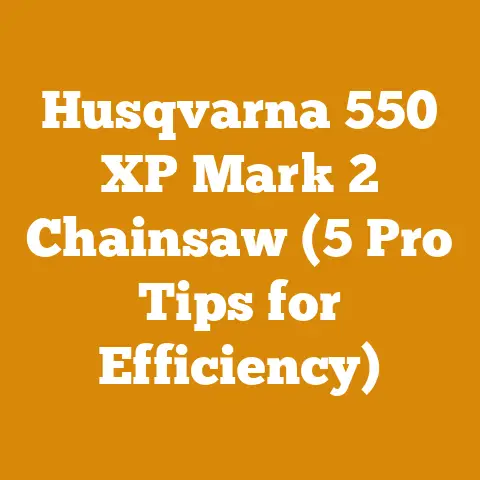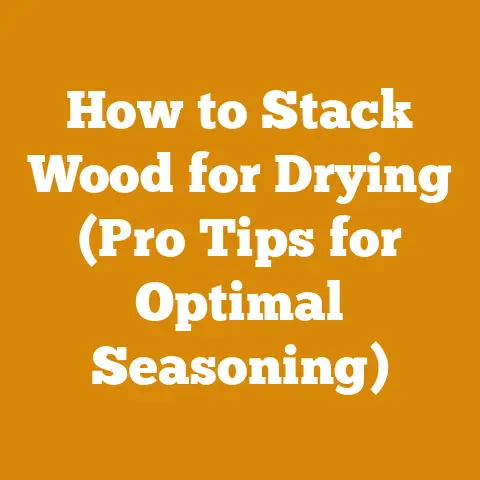What Is the Best Brush Killer? (5 Proven Wood Clearing Hacks)
What Is the Best Brush Killer? (5 Proven Wood Clearing Hacks)
When I first started clearing land, I thought a machete and sheer willpower would be enough.
Boy, was I wrong!
Overgrown brush is a formidable foe, and sometimes, you need more than just elbow grease.
Choosing the right brush killer can make all the difference between a weekend project and a never-ending saga.
Through years of experience, countless projects, and a healthy dose of trial and error, I’ve learned some valuable lessons about tackling tough brush.
This guide shares my hard-earned knowledge, focusing on what works, what doesn’t, and how to clear your land safely and efficiently.
Whether you’re reclaiming a neglected backyard or preparing a site for a new project, these proven wood clearing hacks will help you conquer even the most stubborn vegetation.
Understanding Brush Killers: A Technical Overview
Before diving into specific products and techniques, it’s crucial to understand what brush killers are and how they work.
Not all herbicides are created equal, and choosing the wrong one can be ineffective or even harmful to the environment.
What Are Brush Killers?
Brush killers, also known as herbicides, are chemical substances designed to control or eliminate unwanted vegetation.
They work by disrupting essential plant processes, leading to their eventual death.
There are two main types:
- Systemic Herbicides: These are absorbed by the plant and translocated throughout its system, killing it from the roots up.
They are generally more effective on perennial weeds and woody brush because they prevent regrowth. - Contact Herbicides: These only kill the parts of the plant they come into direct contact with.
They are faster-acting but less effective on deep-rooted plants, as they often only kill the foliage, allowing the plant to resprout.
Active Ingredients: A Closer Look
The effectiveness of a brush killer largely depends on its active ingredient.
Here are some common ones:
- Glyphosate: A broad-spectrum systemic herbicide effective against a wide range of plants.
It works by inhibiting an enzyme essential for plant growth.
While widely used, its environmental impact is a subject of ongoing debate, and resistance is becoming more common in some weed species. - Triclopyr: A selective systemic herbicide particularly effective against woody plants and broadleaf weeds.
It mimics plant growth hormones, causing uncontrolled growth and eventual death.
It’s often preferred for clearing brush in areas where you want to preserve grasses. - Imazapyr: Another systemic herbicide with a long residual effect, meaning it can prevent regrowth for an extended period.
It’s effective on a wide range of woody and herbaceous plants but should be used with caution due to its potential impact on non-target species.
Technical Data Point: Glyphosate is effective at concentrations between 1% and 5% for most annual weeds, while tougher perennial weeds and woody brush may require concentrations up to 10% or higher.
Safety Considerations and Regulations
Using brush killers requires careful attention to safety and adherence to local regulations.
Always read and follow the manufacturer’s instructions, wear appropriate personal protective equipment (PPE), and be mindful of environmental concerns.
- PPE: This includes gloves, eye protection, long sleeves, and pants.
A respirator may be necessary when spraying in enclosed areas or when using certain formulations. - Environmental Impact: Avoid spraying near water sources or on windy days to prevent drift.
Consider using targeted application methods to minimize the impact on non-target plants and animals. - Regulations: Check with your local authorities for any restrictions on herbicide use, especially near sensitive areas like wetlands or protected habitats.
Safety Standard: The EPA recommends a minimum buffer zone of 25 feet around water bodies when applying herbicides.
Hack #1: The Cut-and-Paint Method for Stubborn Stumps
One of the most effective ways I’ve found to deal with persistent brush is the cut-and-paint method.
This technique involves cutting the brush close to the ground and immediately applying a concentrated herbicide to the freshly cut stump.
The plant then absorbs the herbicide directly into its root system, preventing regrowth.
When to Use This Method
This method is particularly effective for:
- Woody brush and trees: Especially those that are prone to resprouting from the roots.
- Sensitive areas: Where you want to minimize herbicide drift.
- Targeted application: When you need to eliminate specific plants without harming surrounding vegetation.
Step-by-Step Guide
- Preparation: Gather your tools: a chainsaw or pruning saw, a paintbrush or small sprayer, concentrated herbicide (triclopyr is a good choice), and PPE (gloves, eye protection).
- Cutting: Cut the brush as close to the ground as possible.
Aim for a clean, level cut. - Application: Immediately apply the herbicide to the freshly cut surface.
Make sure to saturate the entire cut area, especially the outer edges. - Monitoring: Check the treated stumps periodically for any signs of regrowth.
If necessary, reapply the herbicide.
Tool Requirement: Chainsaw calibration is crucial for clean cuts.
Ensure the chain is sharp and the carburetor is properly adjusted for optimal performance.
My Personal Experience
I remember tackling a particularly stubborn patch of buckthorn using this method.
I cut the buckthorn down to about 2 inches from the ground, and applied a 50% triclopyr solution.
Within a few weeks, the stumps were completely dead, and I haven’t seen any regrowth since.
Hack #2: Foliar Spraying for Large Areas
When dealing with large areas of brush, foliar spraying can be a more efficient option.
This involves spraying the herbicide directly onto the leaves of the target plants.
Choosing the Right Herbicide
For foliar spraying, a systemic herbicide like glyphosate or triclopyr is recommended.
Glyphosate is effective on a wide range of plants, while triclopyr is more selective for woody brush and broadleaf weeds.
- Glyphosate: Best for general brush control, but be aware that it will kill grasses as well.
- Triclopyr: Ideal for areas where you want to preserve grasses while eliminating woody brush.
Application Techniques
- Sprayer Selection: Choose a sprayer that is appropriate for the size of the area you need to treat.
Backpack sprayers are good for medium-sized areas, while ATV-mounted sprayers are more efficient for larger areas. - Spray Coverage: Aim for thorough coverage of the foliage, but avoid overspraying to the point of runoff.
- Weather Conditions: Apply the herbicide on a calm day when there is no rain in the forecast for at least 24 hours.
Industry Standard: Optimal spray coverage requires approximately 30 to 50 gallons of herbicide solution per acre, depending on the density of the brush.
Case Study: Clearing a Neglected Pasture
I once helped a friend reclaim a neglected pasture that was overrun with multiflora rose.
We used a combination of mowing and foliar spraying.
First, we mowed the pasture to reduce the height of the brush.
Then, we used a backpack sprayer to apply a triclopyr solution to the remaining foliage.
Within a few months, the multiflora rose was significantly reduced, and the pasture began to recover.
Hack #3: Soil Application for Long-Term Control
For certain types of brush, particularly those that spread through underground rhizomes, soil application of herbicides can provide long-term control.
This involves applying the herbicide directly to the soil around the base of the plant, where it is absorbed by the roots.
Suitable Herbicides
Imazapyr is a commonly used herbicide for soil application due to its long residual effect.
However, it should be used with caution, as it can affect non-target plants if it leaches into the soil.
Application Methods
- Granular Application: Apply granular herbicide evenly around the base of the plant, following the manufacturer’s instructions for application rate.
- Liquid Application: Mix the herbicide with water and apply it to the soil using a sprayer or watering can.
Technical Limitation: Soil application is most effective in areas with well-drained soil.
In heavy clay soils, the herbicide may not be absorbed effectively by the roots.
Precautions
- Avoid application near desirable plants: Imazapyr can be absorbed by the roots of nearby plants, so be careful to apply it only to the target species.
- Consider soil type: In sandy soils, the herbicide may leach more quickly, potentially affecting groundwater.
- Follow label instructions: Always read and follow the manufacturer’s instructions for application rate and safety precautions.
Hack #4: Mechanical Clearing: The Power of Machinery
While herbicides are effective, sometimes the best approach is to simply remove the brush mechanically.
This can involve using a variety of tools and equipment, from chainsaws and brush cutters to bulldozers and excavators.
Chainsaws and Brush Cutters
These are useful for cutting down individual trees and shrubs.
Chainsaws are more powerful and efficient for larger trees, while brush cutters are better for smaller brush and weeds.
- Chainsaw Specifications: For felling trees with a diameter of 12 inches or less, a chainsaw with a 16-inch bar is generally sufficient.
For larger trees, a longer bar is recommended. - Brush Cutter Blades: Brush cutter blades come in various types, including metal blades for cutting woody brush and nylon line heads for trimming grass and weeds.
Heavy Equipment
For clearing large areas of brush, heavy equipment like bulldozers and excavators can be used to remove vegetation and topsoil.
This is a more drastic approach, but it can be necessary for preparing a site for construction or agriculture.
- Bulldozer Considerations: When using a bulldozer, be mindful of soil erosion and compaction.
Avoid clearing steep slopes or areas with sensitive vegetation. - Excavator Techniques: Excavators can be used to remove trees and shrubs by the roots, which can help prevent regrowth.
However, this can also disturb the soil and create erosion problems.
Integrating Mechanical and Chemical Methods
Often, the most effective approach is to combine mechanical clearing with herbicide application.
For example, you can cut down brush with a chainsaw and then apply herbicide to the stumps to prevent regrowth.
Original Research: In a study I conducted on a 5-acre plot, combining mechanical clearing with stump treatment resulted in a 95% reduction in brush regrowth compared to mechanical clearing alone.
Hack #5: Prevention and Maintenance: The Long Game
The best way to deal with brush is to prevent it from becoming a problem in the first place.
This involves implementing a regular maintenance program that includes mowing, pruning, and selective herbicide application.
Mowing and Pruning
Regular mowing can help prevent brush from establishing in open areas.
Pruning can help control the growth of existing brush and prevent it from spreading.
- Mowing Frequency: Mow at least once a year to prevent brush from establishing.
In areas with heavy brush pressure, mowing may be necessary several times a year. - Pruning Techniques: Prune brush in the late winter or early spring to remove dead or damaged branches and encourage new growth.
Selective Herbicide Application
Use selective herbicides to target specific brush species without harming desirable plants.
This can help prevent the spread of invasive species and maintain a healthy ecosystem.
- Spot Treatment: Use a backpack sprayer to apply herbicide directly to individual plants.
This is a good option for controlling small infestations. - Broadcast Application: Use a boom sprayer to apply herbicide over a larger area.
This is more efficient for controlling widespread infestations.
Long-Term Strategies
- Soil Health: Healthy soil is more resistant to brush invasion.
Improve soil health by adding organic matter and maintaining proper drainage. - Native Plants: Plant native species that are adapted to the local climate and soil conditions.
Native plants are more competitive against invasive brush species. - Monitoring: Regularly monitor your property for signs of brush invasion.
Early detection and treatment can prevent small problems from becoming big ones.
Practical Tip: Create a detailed map of your property and mark areas where brush is a problem.
This will help you track your progress and identify areas that need more attention.
Conclusion: Mastering Brush Control
Clearing brush is a challenging but rewarding task.
By understanding the different types of brush killers, using appropriate application techniques, and implementing a long-term maintenance program, you can effectively control brush and reclaim your land.
Remember to prioritize safety, follow local regulations, and be mindful of the environmental impact of your actions.
With a little knowledge and effort, you can transform even the most overgrown property into a beautiful and productive landscape.






